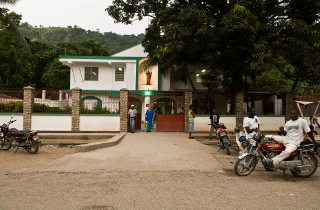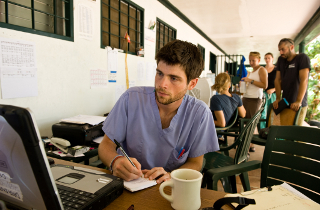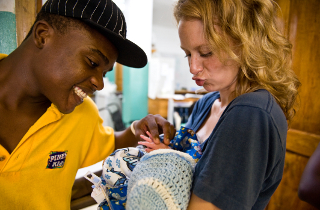A Season of Hope
By Leslie Macmillan
Tufts medical students take steps to create a permanent rotation in Haiti
In the slideshow above, Sally Greenwald, A07, M13, talks about working in Haiti. Photos and slideshow by Alonso Nichols
On a hot day in early July, Sally Greenwald, A07, M13, walks across a dusty tent clinic in Milot, Haiti, set up by the local hospital to treat earthquake victims flown in from the capital. She points to a young woman in a wheelchair. Six months after the January 12 earthquake that leveled Port-au-Prince and killed more than 200,000 people, the woman is still here, and lately she has begun to wonder what life holds for her. She has no home, no family and no legs.
“Her name is Marguerite, and she spends every day crying because she’s not married yet, and she thinks no one will ever love her,” says Greenwald. “But last week she had a fitting for prosthetics. She’ll get legs soon.”
Haitians have seen many foreign medical teams come and go since the earthquake, but Greenwald and six other Tufts medical students came to Haiti to build something more enduring. They want to start a permanent rotation clinic, hopefully by next summer, at the hospital in Milot, where Tufts students and faculty, matched by clinical and research interests, can work on projects to improve health care in this area of northern Haiti. The students, in turn, will learn about medicine in the developing world.
With a spark of an idea and a lot of good will, the students started planning for a Haiti rotation in fall 2009. When the earthquake struck, rather than putting an end to the students’ plan, it only added urgency, and their trip soon got the full backing of the medical school.
Twelve faculty members, including Joyce Sackey, dean for multicultural affairs and global health, signed on to spend a week apiece in Haiti this past summer supervising the students; the medical school and the Tisch College of Citizenship and Public Service provided funding. Tufts physician Mark Pearlmutter, M84, chief of emergency medicine for Caritas Christi Health Care, suggested basing the rotation at Hôpital Sacré Coeur in Milot, 70 miles north of Port-au-Prince, where he had previously done some work. In mid-June the students were off to spend six weeks in Milot, a quiet town edged by mountains.
Care Through the Night

The entrance to the Hôpital Sacré Coeur in Milot, 70 miles north of Port-au-Prince. Photo: Alonso Nichols
Many of the earthquake victims still here—some 200 of the original 500—are suffering from secondary problems such as massive bedsores and infection, the result of languishing for six months in a hospital system that is overwhelmed and reliant on volunteer teams of clinicians from overseas.
Having just completed their first year of medical school, the Tufts students mostly observe and assist physicians, but they are each assigned patients and do what they can to improve care, both for earthquake victims and other patients. They climb out of bed at midnight and 3 a.m. to turn patients in the ICU so they don’t develop bedsores. They review reams of patient charts, which are kept manually.
In the longer-term, students hope to launch public health projects to address some of Haiti’s longstanding health issues, such as cervical cancer. Rates of the disease on the island are among the highest in the world, according to a 2008 study sponsored by the Centers for Disease Control and other organizations. The students tested some 300 women for cervical cancer; roughly 6 percent showed signs of pre-cancer and required treatment. Many had never been to a doctor.
In northern Haiti, as in Port-au-Prince, life is hard and was made harder by a disaster that continues to take its toll. Yet as Greenwald walks through the tent clinic, greeting people in the Creole language she’s been studying, she is met with warm smiles and embraces. Many call her by name; others know her simply by her nickname, “Blanc,” Creole for “White One.”
“Pray for Us”
By the time rounds start at 8 a.m., it is already sweltering in the tents, where daytime temperatures range between 100 and 120 degrees. Lily Conover, M13, helps Joseph, 29, slide prosthetics over neatly bandaged stumps that end just above where his knees used to be.
“They’re good,” Joseph says of the artificial legs he got just two days ago. “But I’m in a little bit of pain. The new legs pinch.”
To put the number of amputees since the earthquake in perspective, American servicemen who have lost limbs in the Iraq and Afghanistan wars number roughly 1,000, and that is considered a significant public health problem in a country with advanced medicine and highly trained physical therapists. In Haiti, a country the size of Massachusetts and where medical care is substandard at best, the number of amputees is four times that.
Conover wonders what will happen when children outgrow their donated artificial legs; she worries about elaborate titanium prosthetics rusting in the tropical humidity. “Having patient advocates after we go, having a prosthetist come down year after year,” she says. “That’s going to be crucial.”
Joseph, a former electrician, has high praise for Conover and the other Tufts students. “I think they do a good job,” he says through an interpreter. “To everyone who came to help Haiti, I want to thank them.” When asked what the future holds for his country, he does not have an answer. He says only, “Pray for us.”
Working within the System

Adam Nadolski, A07, M13, tabulates data from community health interviews at the Hôpital Sacré Coeur compound in Milot, Haiti. Photo: Alonso Nichols
While aid continues to pour into Haiti, the lack of coordination between foreign aid organizations and the institutions they’re meant to help is evident everywhere.
In the hospital compound, students point to pallets of supplies—including hundreds of stacked boxes of latex gloves they have dubbed “Glove Mountain”—languishing under tarps in the tropical sun and clogging entryways. At the same time, basic necessities such as fly strips for the operating rooms and footwear for artificial legs are in short supply.
Critics blame the lack of coordination between the government and outside aid agencies, which, Haitian government officials say, prefer to work independently within the country. The students are aware of the problem, and that is one reason they’re committed to working within the Haitian health system rather than around it.
In addition to being supervised by Tufts doctors, the students also work with Haitian physicians. In the tents, Jerry Bernard, a Haitian physician at Sacré Coeur, examines a woman who lost three toes to complications from diabetes. In this tropical climate, many wounds fester in the heat and become infected. Conover holds the woman’s foot while Bernard shows her, Adam Nadolski, A07, M13, and Greenwald how to drain the open wound.
“We’ve all learned a lot from the Haitian doctors,” says Greenwald. “Their medical diagnosis skills are awesome. In the U.S., everything is lab-based. We rely on tests, but they can spot anemia from across the room.”
Extra Eyes and Ears
In the tent clinic, sticky strips thick with black flies hang from ceilings where electric fans stir a faint breeze over rows of identical cots.
Rosemerta, a woman in her mid- to late-fifties—she’s unsure of her precise age—lies on her side in a long white dressing gown. Her husband died in the earthquake, and she was hit in the spine by a falling beam, losing the use of her legs. Her injuries are being monitored for infection. When Graham Brant-Zawatsky, M13, who sports a beard and a broad smile, approaches the cot, she sits up and smiles. In six months, he’s the only medical person she’s gotten to know by name.
Patient records are kept manually in the tent clinics, and with different medical teams rotating in and out every week, charts are intermittently updated and seldom reviewed in this crisis environment. Brant-Zawatsky, who earned his undergraduate degree in religion, has spent many hours reviewing thick binders of handwritten charts, including Rosemerta’s.
“When I came in I went back through her chart and realized she’s basically been on Cipro [a powerful antibiotic] nonstop,” says Brant-Zawatsky. “I want to make sure it’s used for a good reason, and if it’s not working, I want to ask her doctors about switching her off it.” Prolonged antibiotic use can weaken the immune system and lead to infection.
The students realize that such attention to detail may not always happen when they leave, but they say they do what they can while they are here.
“Shortly after arriving here another volunteer said to me, ‘If you see it, you’re responsible for it,’ ” says Nadolski. “I definitely feel that way. We have made promises to these people and the friends we have made here. We need to see them through.”
A Break in the Suffering

Sally Greenwald, A07, M13, with Samuel and his uncle at the hospital in Milot. Photo: Alonso Nichols
After four weeks in Haiti, the Tufts team has seen its share of shattered bones and lives. Then there is an unexpected break in the suffering.
Celita, an elementary school principal, was three months pregnant when a falling beam at the school crushed her spine. “The doctors said she would never walk again if they didn’t operate, but she wouldn’t let them X-ray her back because she knew it would hurt the baby,” says Greenwald. “Then one day she got up, and she started walking.” On July 2, Celita gives birth to a 7-pound, healthy baby boy, with Greenwald assisting in the C-section.
Long before the students left for Haiti, their supporters at the medical school predicted the experience would leave a lasting impact—on both them and their patients. “We are supporting the students not for a one-time event,” Sackey said during a planning meeting in Boston last spring. “We expect when they come back, they will be telling their stories.”
With two weeks left in her stay, Greenwald is already telling stories, and the one she tells most often is a tale of overcoming great odds: the woman they thought would never walk again, the baby who wasn’t supposed to be born.
Does the story say something about Haiti?
“I think so,” says Greenwald, cradling the baby, who is named Samuel. “People are strong here,” she says. “People are tough. But if you let them, they’ll embrace you.”
Leslie Macmillan can be reached at leslie.macmillan@tufts.edu.
